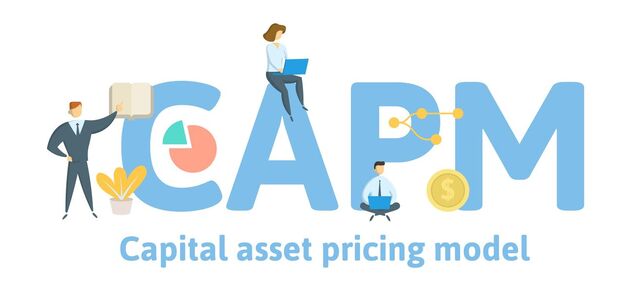
What is Capital Asset Pricing Model
Everything revolves around the question of values. The most important driver of values is the returns you expect in the stock that determines value.
Cost of Equity is an expected rate of return required by the investors to invest in the company’s shares. The equity investors require:
- a Risk-Free Rate, plus
- Equity Risk Premium, which is an additional return to compensate for the risk involved in investing in the company’s shares.
The Capital Asset Pricing Model (CAPM) explains the relationship between the systematic risk and the expected return on assets, particularly stocks. This model is used to compute the cost of equity and helps you value risky securities and evaluate expected returns on assets.
Understanding Capital Asset Pricing Model
The Capital Asset Pricing Model (CAPM) is a widely used financial model that helps investors and analysts understand the relationship between risk and return for individual assets. It provides a framework for estimating the expected return of an asset based on its risk compared to the overall market
Key concepts in understanding Capital Asset Pricing Model CAPM:
- Risk and Return: CAPM is based on the principle that investors require higher returns for taking on higher levels of risk. Investors expect to be compensated for the additional risk they bear when investing in risky assets like stocks compared to risk-free assets like government bonds.
- Systematic Risk: Capital Asset Pricing Model focuses on systematic risk, also known as market risk, which is the risk that cannot be diversified away by holding a well-diversified portfolio. Systematic risk is influenced by overall market factors and economic conditions.
- Beta (β) Coefficient: Beta is a measure of an asset's sensitivity to market movements. It represents the asset's systematic risk. A beta of 1 indicates the asset moves in line with the market. A beta greater than 1 suggests higher volatility, and a beta less than 1 indicates lower volatility compared to the market.
- Risk-Free Rate: CAPM uses a risk-free rate to represent the return investors can earn from a risk-free investment, such as government bonds. The risk-free rate serves as the baseline return that investors require for taking on any risk.
- Market Risk Premium: The difference between the expected return of the overall market (represented by a market index) and the risk-free rate is known as the market risk premium. It represents the additional return investors expect to earn for holding a risky market portfolio compared to a risk-free asset.
What is Capital Asset Pricing Model (CAPM) Formula and Calculation
Expected Return = Risk-Free Rate + Beta x ( Market Return - Risk-Free Rate )
Using the CAPM formula, investors can estimate the expected return of an asset based on its beta and the market risk premium.
The formula for calculating the expected return of an asset given its risk is as follows:
ra = rf + [ βa x ( rm - rf ) ]
Where,
rf = Risk-Free Rate
βa = Beta of the security
rm = Expected Market Return
Simply,
Cost of Equity = Risk-Free Rate + Equity Risk Premium, where
Risk-Free Rate = Real Interest Rate + Expected Inflation Rate
Equity Risk Premium = Beta x (Expected Returns in the Market - Risk-Free Rate)
The Expected Returns in the Market represents the additional return expected by investors to invest in the equity market versus risk-free government bonds.
The Beta coefficient is the measure of volatility or systematic risk of the stock in comparison to the market as a whole. The individual stocks tend to be riskier or less risky than the market and the Beta measures this risk. Beta is easily obtainable from various financial online sites.
Beta is generally historic and does not reflect the changes in the business or the financial structuring that the company has undergone recently. One must always review the Beta with the following factors, such as
- Nature of its products and services (FMCG companies tend to have lower Beta), cyclical companies tend to have higher Beta
- Proportion of fixed to variable costs
- A higher operating profit margin for a company should relatively have a lower Beta
- A company with higher debt will have a higher Beta
The expected return on equity varies across investor types. For example, venture capitalists would demand higher returns than stock market investors. Returns also depend on the lifecycle stage of a company.
In case if you find computing Beta and cost of equity under the Capital Asset Pricing Model (CAPM) cumbersome, then you may use a hurdle rate as cost of equity or expected market returns as cost of equity, or any other reference as the cost of equity.
CAPM Example
Example for Computing Cost of Equity using CAPM for Company X
We now compute the Cost of Equity in Table 1 for Company X based on the following assumptions
Assumptions
| Risk-Free Rate | 6% |
| Expected Inflation Rate | 5% |
| Expected Returns Over Inflation | 7% |
| Expected Market Returns | 12% |
| Beta | 0.75% |
ra = rf + [ βa x ( rm - rf ) ]
Where,
rf = Risk-Free Rate
βa = Beta of the security
rm = Expected Market Return
Thus, the computation of Cost of Equity is computed in Table 1 below:
Table 1
Risk-Free Rate + Beta x (Expected Market Returns – Risk-Free Rate)
6% + 0.75 x (12% - 6%) = 10.5%
Expected Market Returns (12%) in the above Example is inflation plus expected returns over inflation i.e. 5% + 7%.
Key Takeaways - Capital Asset Pricing Model (CAPM):

- CAPM calculates expected asset return using market return, risk-free rate, and asset's market sensitivity (beta).
- Despite limitations like unrealistic assumptions and linear risk-return view, CAPM remains widely used due to its simplicity.
- Cost of Equity is an expected rate of return required by the investors to invest in the Company’s shares. The Equity Investors require:
- A Risk-Free rate, plus
- Equity Risk Premium, which is an additional return to compensate for the risk involved in investing in the Company’s shares.
Frequently Asked Questions
Does Capital Asset Pricing Model Work

The Capital Asset Pricing Model (CAPM) is a widely used financial model that has been foundational in finance for decades. While CAPM provides valuable insights into the relationship between risk and return, it is essential to understand its strengths and limitations to assess its effectiveness in practical applications
Strengths of Capital Asst Pricing Model (CAPM):
- Theoretical Framework: CAPM provides a theoretical framework for understanding the risk-return trade-off and the pricing of risky assets in a systematic way.
- Simplicity: CAPM is relatively simple to use and understand, making it accessible to a broad audience, including investors, analysts, and academics.
- Market Consistency: CAPM aligns with the notion that investors require higher returns for taking on higher levels of systematic risk. It provides a benchmark to compare asset returns with market expectations.
- Cost of Capital Estimation: CAPM is commonly used to estimate the cost of equity, which is essential in determining the appropriate discount rate for valuing assets and projects.
Limitations of Capital Asset Pricing Model (CAPM):
- Assumptions: CAPM is based on several assumptions, including efficient markets, homogenous expectations, and a linear relationship between beta and expected return. These assumptions may not always hold in real-world markets.
- Risk Measurement: CAPM solely focuses on systematic risk (beta) and overlooks other sources of risk, such as firm-specific risk or idiosyncratic risk. Therefore, it may not fully capture the total risk of an asset.
- Data Requirements: Accurate estimation of CAPM parameters, such as beta, requires reliable historical data and might be sensitive to data frequency and time periods.
- Market Efficiency: CAPM assumes market efficiency, implying that asset prices always reflect all available information. However, real-world markets may not always be perfectly efficient.
- Diversification: CAPM assumes investors can diversify away all unsystematic risk. In practice, some level of diversifiable risk remains, especially for individual assets or small portfolios.
Effectiveness in Practice :
While CAPM provides valuable insights and serves as a foundational model in finance, its practical effectiveness has been a topic of debate. Some researchers argue that CAPM has limitations and may not fully capture market complexities. As a result, alternative models and techniques have been developed to address these limitations and provide more accurate asset pricing and risk assessment.
In summary, CAPM is a useful tool for understanding the relationship between risk and return, but its practical effectiveness depends on the context and the specific characteristics of the assets being analyzed. It is often used as a starting point in financial analysis, and investors may complement it with other models and qualitative assessments to make well-informed investment decisions.
Capital Asset Pricing Model (CAPM) and the Efficient Frontier
The Capital Asset Pricing Model (CAPM) and the Efficient Frontier are two key concepts in finance that help investors make informed decisions about constructing investment portfolios.. I have explained the CAPM let me briefly explain the efficient frontier.
Efficient Frontier
The Efficient Frontier represents the set of optimal portfolios that offer the highest expected return for a given level of risk, or the lowest risk for a given level of expected return. It illustrates the trade-off between risk and return in constructing a diversified portfolio. Portfolios that lie on the Efficient Frontier are considered efficient because they provide the best risk-return profile.
Investors aim to create portfolios that lie on or above the Efficient Frontier to maximize returns while managing risk. Diversification across different assets helps achieve this goal. The Efficient Frontier can be graphed to visualize the various portfolios and their risk-return characteristics.
In summary, the CAPM helps determine the expected return of an individual asset, while the Efficient Frontier guides investors in constructing diversified portfolios to optimize risk and return. These concepts are crucial tools in modern portfolio theory, assisting investors in making rational investment decisions based on their risk tolerance and return objectives.
Capital Asset Pricing Model (CAPM) and the Security Market Line (SML)
Security Market Line (SML)
The Security Market Line is a graphical representation of the CAPM equation. It plots the relationship between an asset's expected return and its beta on a graph. The SML acts as a benchmark line that shows the expected return an asset should provide based on its risk, given the risk-free rate and the market risk premium.
Assets above the SML are considered underpriced because they offer higher returns for the given level of risk. Conversely, assets below the SML are overpriced since they provide lower returns for the same level of risk.
Investors can use the SML to assess whether an asset is appropriately priced relative to its risk. If an asset's expected return is below the SML, it suggests that the asset may not offer sufficient return for its level of risk, and vice versa.
In conclusion, the CAPM provides a theoretical framework to estimate asset returns based on risk, while the Security Market Line is a visual representation of this relationship. Together, they assist investors in evaluating investment opportunities, assessing whether assets are fairly priced, and constructing portfolios that align with their risk-return preferences.
Practical Value of the Capital Asset Pricing Model
The Capital Asset Pricing Model (CAPM) holds significant practical value in the field of finance and investment for various reasons:
- Cost of Capital Estimation: CAPM is used to estimate the cost of equity, which is a crucial component in calculating a company's overall cost of capital. This is essential for determining the minimum return a company needs to generate to satisfy its shareholders and investors.
- Investment Decisions: CAPM aids investors in evaluating the risk-return trade-off of potential investments. By comparing an asset's expected return based on its beta to the risk-free rate, investors can decide whether an investment aligns with their desired risk profile.
- Portfolio Construction: CAPM guides the construction of well-diversified portfolios. Investors can select assets that offer higher expected returns for a given level of risk (above the Security Market Line) and optimize their portfolio allocation accordingly.
- Pricing Securities: CAPM helps investors and financial analysts assess whether a security is overvalued or undervalued based on its expected return and risk. If a security's expected return deviates from what CAPM predicts, it may present a buying or selling opportunity.
- Benchmarking: CAPM provides a benchmark return for a specific level of risk. Investment managers can use this benchmark to evaluate their own performance and determine whether their portfolio's returns justify the assumed risk.
- Corporate Finance: CAPM plays a vital role in evaluating investment projects within a company. It assists in determining the appropriate discount rate for calculating the net present value (NPV) of future cash flows.
- Regulatory Compliance: Many regulatory bodies and financial institutions use CAPM or similar models to assess the risk and expected return of financial products, helping ensure fair pricing and transparency.
- Academic Research: CAPM serves as a foundation for academic research and financial literature. It has paved the way for developing more advanced models that consider additional factors and market anomalies.
- Risk Management: CAPM allows risk assessment on a systematic level. It helps investors differentiate between systematic risk (beta-related) and unsystematic risk (company-specific), aiding in risk management strategies.
- Investor Education: CAPM enhances investors' understanding of the relationship between risk and return. It encourages informed decision-making and helps individuals assess investment options more effectively.
While CAPM has its limitations and is subject to criticism, its practical application remains valuable for investors, financial professionals, and businesses for making informed investment decisions, constructing portfolios, and estimating required returns.
